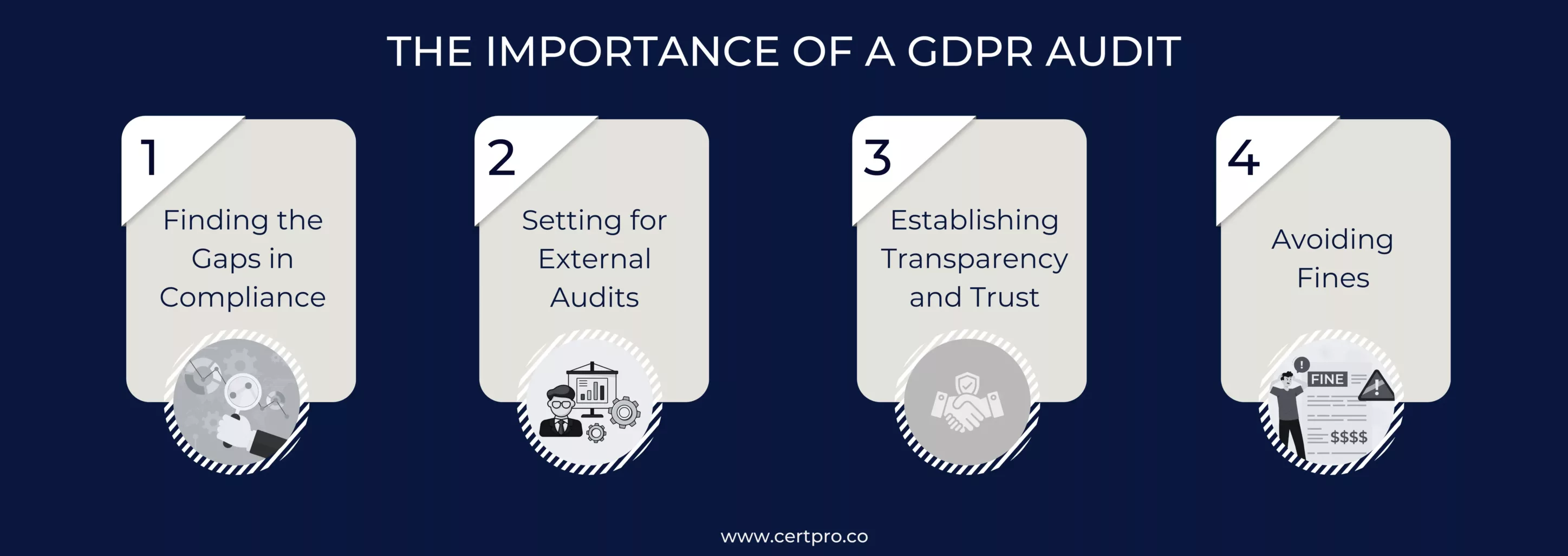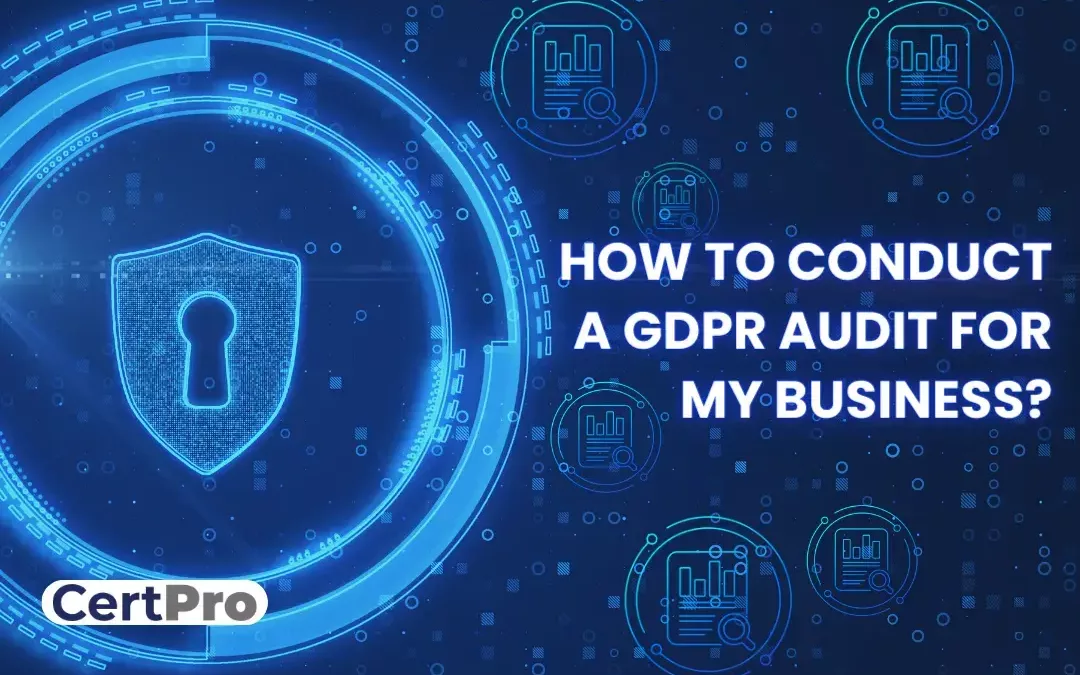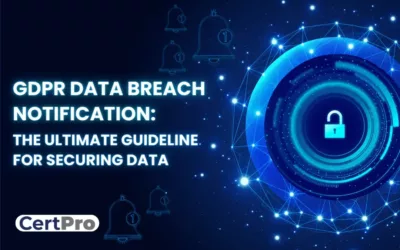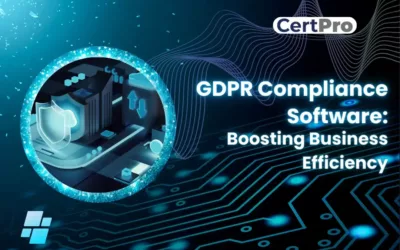The General Data Protection Regulation (GDPR) is vital for today’s digital landscape. It is a cornerstone for safeguarding people’s privacy rights in the European Union (EU). Therefore, organizations dealing with EU residents’ data must follow these GDPR rules. Conducting regular GDPR audits is essential for ensuring and maintaining compliance. By doing this, companies can reduce the chances of non-compliance. It creates a suitable environment for keeping data private, as the GDPR requirements require.
Embarking on a GDPR compliance audit may initially seem overwhelming. However, procedures are crucial to ensuring your organization aligns with GDPR rules. Thus, many organizations seem overwhelmed with the details of executing a comprehensive GDPR audit. We’re here to guide you through conducting one effectively. You can confidently conduct one in your organization by following the steps in this blog.
ABOUT GDPR COMPLIANCE AUDIT
A GDPR compliance audit thoroughly reviews an organization’s data-related policies, procedures, and practices. It aims to measure the degree to which these aspects conform to the specific requirements and principles outlined in the GDPR.
First, organizations must adhere to rules for collecting, processing, storing, and transferring data. Consequently, organizations must be transparent and accountable when handling personal information. Secondly, the audit identifies weaknesses in the organization’s data management that may not meet GDPR standards or require improvement. These findings guide corrective actions and enhancements of comprehensive GDPR compliance.
THE IMPORTANCE OF A GDPR AUDIT
A GDPR Compliance Audit holds significant importance for several reasons:
Finding the Gaps in Compliance: Organizations can objectively review their data policies and processes through audits. This helps find areas that need improvement. Accordingly, this proactive approach allows for a timely resolution.
Setting for External Audits: Regulatory bodies like the ICO may conduct audits to ensure GDPR compliance. Hence, internal audits help organizations remain prepared for external reviews. This ensures compliance and the ability to show adherence to regulations.
Establishing Transparency and Trust: Demonstrating compliance through audits enhances trust and confidence among customers and stakeholders. In addition, it shows dedication to protecting people’s data rights. Also, it promotes transparency and accountability in data handling practices.
Avoiding Fines: Non-compliance with GDPR can lead to hefty fines. Consequently, organizations can minimize the risk of penalties by identifying and rectifying compliance issues through audits. Therefore, it safeguards the reputation and financial stability of the organization.

GDPR AUDIT STEPS FOR YOUR BUSINESS
Look at the essential steps of conducting a GDPR audit for your business.
1. Create an Audit Plan: In the initial phase, crafting a detailed plan that aligns with GDPR requirements is crucial. While ISO templates can help structure the process. However, it may not directly cover GDPR specifics. The plan should assess EU resident data for effective compliance. Consequently, assigning responsibility for data handling and implementing authentication procedures is necessary. Again, updating data repositories post-removal is needed. Therefore, the audit plan must address EU residents’ data exposure, encryption, and notification. Besides, documenting cases with a forensic audit trail is recommended. Thus, organizations should consider some aspects when developing a GDPR audit plan. It covers the data lifecycle, classification, risk management, security, and supply chain. This assertive approach ensures ongoing compliance and minimizes data handling risks.
2. Identify Compliance Gaps and Report the Findings: It’s essential to evaluate your GDPR compliance program. It involves checking records, processing access requests, and using technical security measures. Also, follow privacy rules and data transfer methods. Accordingly, the GDPR’s impact extends across various departments within an organization. During the audit’s discovery phase, interviews and policy reviews will be conducted. Thus, it includes those managing governance, operations, or technical controls. This phase aims to gauge the organization’s alignment with GDPR rules. Hence, discovery sessions are crucial to assessing how well the organization meets GDPR requirements. It includes data processing, privacy principles, security controls, and data transfer methods.
During this phase, the auditors evaluate if the organization follows GDPR rules. This includes access requests, privacy guidelines, tech security controls, and continuous compliance monitoring. Following the discovery phase, auditors outline existing procedures and identify differences. They create a report showing how well the organization follows GDPR rules. The report may offer detailed insights for necessary adjustments. Then, provide a concise assessment, categorizing findings as “aligned” or “not aligned. It is vital to take corrective action for issues classified as “not aligned.”
3. Prioritize and Resolve the Gaps: Subsequently, the audit team must prioritize non-compliant areas based on risk levels. After that, emphasizing a risk-based approach is essential. It considers regulators’ focus on breaches and handling requests from individuals to access their data. Therefore, factors like likelihood, severity of non-compliance, and how it affects the business. Then, begin by addressing high-risk areas identified in the discovery phase.
Addressing gaps usually requires a partnership among various individuals or teams. Therefore, assign tasks to appropriate remediation owners and set realistic deadlines. Certain remediation efforts, such as technical updates or training staff on managing data, require extra time and resources. Similarly, allocate budgets and resources accordingly to facilitate effective remediation.
4. Evaluate the Remedial Actions: It takes significant time and resources to identify and rectify compliance gaps. After addressing compliance gaps, the organization verifies whether it follows GDPR rules. This means testing controls well to ensure gaps are closed and resolve any new issues that may arise. Therefore, highlighting the significance of auditing to confirm compliance post-gap closure is crucial.
Furthermore, this process is ongoing. Regular audits are vital to ensure the efficiency of privacy and compliance programs. Consistent monitoring and enforcement are necessary to evaluate the effectiveness of GDPR requirements. Accountability remains a core principle of the GDPR.
UNDERSTAND THE GDPR AUDIT CHECKLIST
Governance and Accountability: In conducting a GDPR audit, management and accountability are paramount. This involves clearly defining the organization’s data protection roles, responsibilities, and reporting lines. Also, robust policies, procedures, and training are needed to follow GDPR rules. Consequently, keeping thorough records of processing activities is essential for transparency and accountability. Therefore, implementing data protection from the start ensures privacy at every processing stage. Conducting Data Protection Impact Assessments (DPIAs) finds and resolves risks to data privacy. Finally, having well-defined data breach reporting procedures is vital. It helps to promptly address and notify authorities of any security incidents.
Legal Basis for Processing: A GDPR audit involves documenting the legal basis for processing and using valid consent procedures. It also includes conducting legitimate interests and reviewing contracts with vendors. This includes identifying legal justifications for data processing, managing consent effectively, assessing legitimate interests, and verifying third-party compliance. These measures uphold GDPR requirements and safeguard individuals’ rights and data privacy.
Subject Rights: In a GDPR audit, procedures for handling data subject rights requests are critical. Therefore, they are involved in establishing efficient ways to handle Data Subject Access Requests (DSARs). This ensures people can easily use their rights to access, erase, and add objects to data. Specifically, implementing transparent and streamlined procedures for responding to DSARs is very important. Moreover, it deals with erasure requests. It also helps with objections, following GDPR rules, and making data processing clear.
Data Transfers and Sharing: Due diligence on vendors and third-party partners is essential in GDPR audits. Therefore, it means setting up detailed procedures to check how to handle data. This ensures the organization is following GDPR rules. Additionally, establishing data-sharing agreements with third parties helps to regulate data transfers. Consequently, legal tools like standard contractual clauses help ensure compliance with GDPR and safeguard data privacy across international borders.
Data Retention and Disposal: In a GDPR audit, it’s crucial to assess data handling practices. This includes implementing measures for data minimization, which ensures only the necessary data is collected and processed. To follow GDPR rules, it’s vital to document when data is kept and deleted. Secure methods must be used to prevent unauthorized access or breaches. When data is no longer needed, these methods minimize the risks of data breaches.
Data Security: During a GDPR audit, evaluating organizational and technical security controls is crucial. This means using encryption to keep data safe, and physical security measures should be used to restrict access. Establishing a cyber threat management program and incident response planning helps mitigate risks. Also, ensuring staff get security training and checks helps protect data better. This follows GDPR rules and strengthens the organization against possible threats.
Monitoring and Logging: In a GDPR audit, conducting data inventories to map information flows is essential. This ensures a clear understanding of data processing activities. Maintaining detailed data processing records, as GDPR Article 30 requires, shows compliance. Regularly checking and monitoring compliance helps follow GDPR rules. It helps find and fix any problems or breaches quickly.
SECURE GDPR AUDIT WITH CERTPRO’S EXPERT HELP
Conducting a GDPR audit is crucial nowadays to keep client’s data safe. GDPR rules protect individuals’ data and ensure companies follow privacy laws. Thus, audits recheck the company’s compliance with GDPR. Therefore, it helps avoid fines and builds trust with customers. Regular audits are a way to keep improving and show the company cares about data privacy. It’s not just about following rules but also about doing the right thing to maintain data privacy.
In short, doing GDPR audits is crucial for companies to stay legal, reduce risks, and keep data safe. CertPro is a recognized organization offering GDPR consulting services. The experts can help you understand the areas of concern. Moreover, CertPro provides cost-effective services that guarantee your data security. If you need more information about the GDPR audit and checklist, please contact CertPro.
FAQ
Are there any tools to assist in conducting a GDPR audit effectively?
Yes, there are different tools to help with GDPR rules, like software. Software streamlines audit processes and data assessment. Also, it makes reports, handles requests from people about their data, tracks remediation activities, and keeps records. Some examples include Data Protection Impact Assessment (DPIA) tools, data mapping software, and compliance management platforms.
How often should I check if my business follows GDPR rules?
How often you check depends on various factors, such as the size of your organization, the nature of data processing activities, and changes in regulatory requirements. However, it’s usually good to check every year to keep following the rules.
What happens if you don't follow GDPR rules after an audit?
If you cannot maintain the standard operation of GDPR compliance, your compliance will be discontinued and may increase the risk of data breaches and related penalties.
What are the 4 key components of GDPR?
The four main components of GDPR are the lawful processing of data, purpose limitation, data minimization, and retention. These components secure the data and eliminate risk.
How can CertPro help in your GDPR audit?
CertPro offers expert, customized guidance and cost-effective services for GDPR compliance. It assists your business in meeting legal standards and data security requirements. You can contact CertPro anytime for information related to GDPR compliance. We’re available 24/7 to help you.

About the Author
SUBBAIAH KU
Subbaiah Ku is the Regional Director for CertPro in Oman, bringing a wealth of expertise in process and system auditing. As a seasoned lead assessor, Subbaiah is dedicated to ensuring the highest standards in compliance and security. His unique blend of technical acumen, rooted in Mechanical Engineering, is complemented by a diverse range of certifications and extensive training.
GDPR DATA BREACH NOTIFICATION: THE ULTIMATE GUIDELINE FOR SECURING DATA
Modern businesses require incorporating personal data protection strategies to ensure customer satisfaction and business growth. In this respect, the European Union's General Data Protection Regulation (GDPR) sets strict standards for maintaining data security....
GDPR Compliance Software: Boosting Business Efficiency
Handling large amounts of personal data has become a significant concern in today's digital landscape, necessitating a thorough understanding of the intricate legal framework, particularly within the European Union. An essential piece of legislation in this regard is...
GDPR CERTIFICATION COST IN 2024
The General Data Protection Regulation (GDPR) establishes stringent standards for safeguarding personal information in an era characterized by escalating concerns over data privacy and security. Since its inception in 2018, it has compelled organizations worldwide to...




